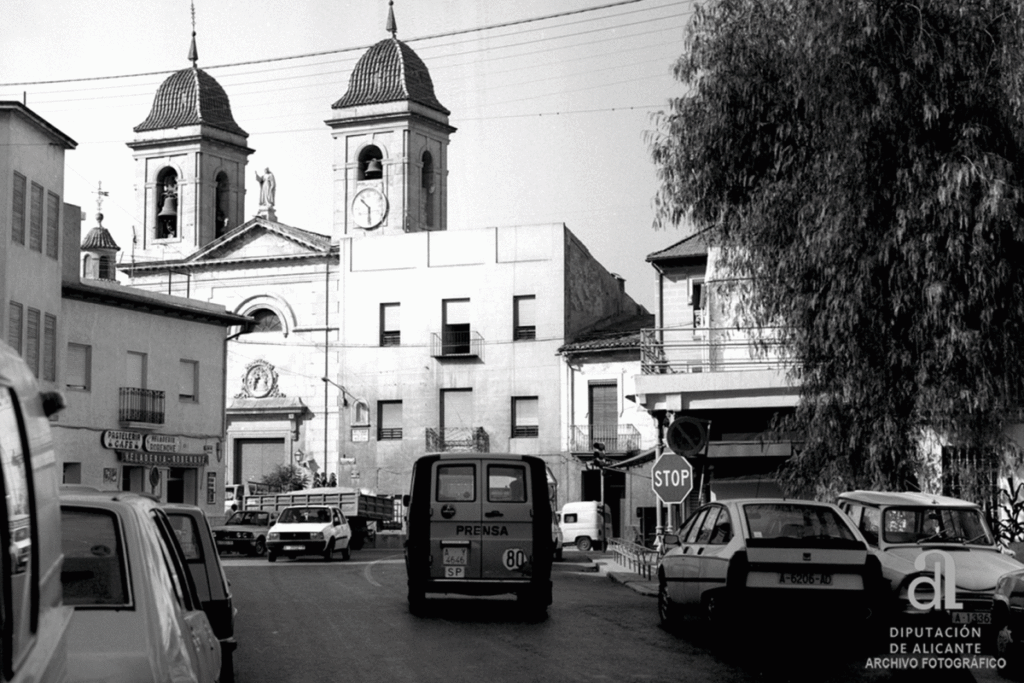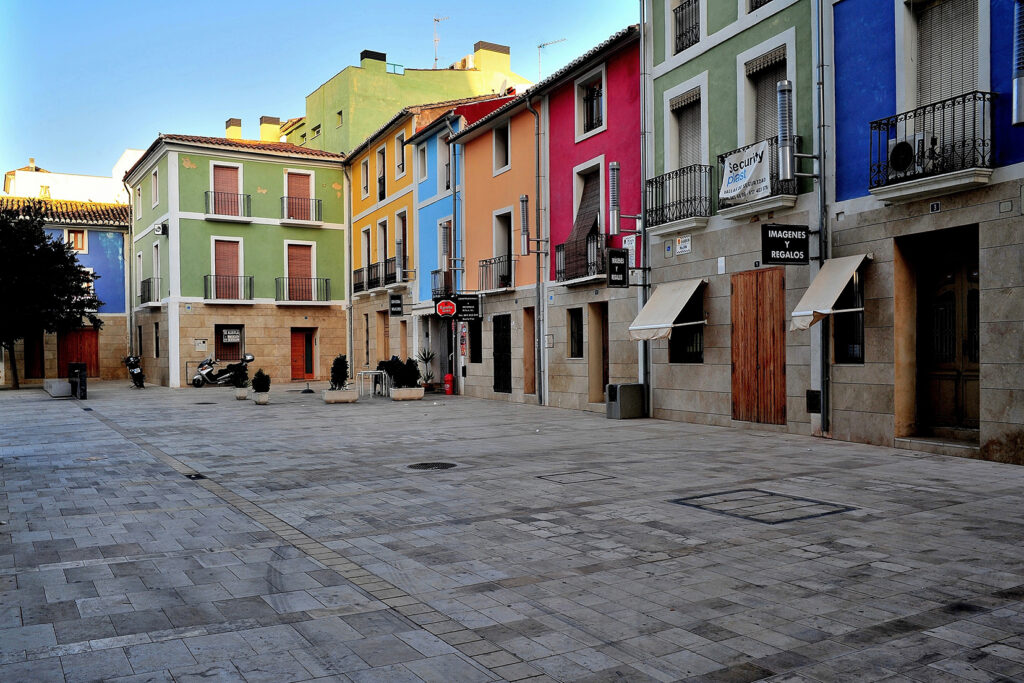Historical Centers
The historic center of Sant Joan d’Alacant was developed from the old route of the irrigation network of the Huerta de Alicante, as well as the roads that linked Alicante with Xixona and Valencia. The development of the historical nucleus was constant. The origin could place it safely in Islamic times. According to chroniclers at this time Sant Joan was on both sides of the Ditch and had its own mosque.
With the arrival of the Christians in the thirteenth century, some changes would occur although the urban layout would remain around the Main Ditch from the Maigmona, where the mill of the King or the Consell was already located, of which we have news since the fourteenth century. In the street parallel to the Maigmona- the current street Cervantes- there must have been important buildings of socioeconomic character of the population as the furnace of Orts.

Section of the street San Antonio, today square Maisonnave. 1984

San Antonio Street. Traditional centre of Sant Joan d’Alacant
At the beginning of the 17th century the new parish church in the current location, very close to the Plaza Maisonnave, known in several periods also as the Market, del Pozo or del Olmo, which must have developed throughout this century in the place where the different main roads that crossed Sant Joan were located. This square would become the socio-cultural and economic center until the middle of the twentieth century, being celebrated among other events, the market garden on Thursdays and Sundays, and this last day, in addition, the market and water auction.
From the church the Calle Mayor was developed whose date of creation is certainly unknown but it is likely that it was around the seventeenth century, since it already appears in a plan of 1689, as a road of great amplitude and rectitude. At the end of this, in the seventeenth century we can see the Plaza de la Cruz, located on the site of some old defensive tower, which forks the streets of San José and Carmen, popularly known as carrer Nou i carrer Baix. The first one reaches the old farmhouse of Benialí where there was a defensive tower and a hermitage dedicated to San José that gave its name to this street, where we can still find the interesting water passages used by the irrigators. The second, following the route of the Greater Ditch, covers from the Plaza de la Cruz to the beginning of the Sèquia Ampla, the place where the ditch was widened and on the way to Benimagrell. Along the route of Calle Mayor there were numerous bridges to cross the ditch.
From the late seventeenth century the streets San Antonio, and del Mar, from the square Maisonnave would be developed. The first one followed the route of the old road of Silla towards Valencia. The second one in the direction of the sea connected with the roads that led to the beach of La Huerta.
Regarding the houses, most are modest farmhouses with a height that varies between ground floor and three floors. The houses were painted in bright and varied colors -as is usual in many Valencian Mediterranean towns- and especially in the nearest towns such as the city of Alicante, Santa Faz or Mutxamel.
Most of these houses have a large door to allow the passage of large agricultural devices or even cavalry, and on their balconies, present interesting iron balustrades. Generally the upper floors were dedicated to the residential area of the house, while the ground floor, it was to store the gadgets and agricultural products space called cambra. Most of these houses have backyards, which were used as a corral or private small garden, and where the latrines of the house would be found, whose excrements once dried and chopped constituted what many orchards called “donut”, a very fertile compost to grow.

Cambra de la Finca La Princesa (Sant Joan d’Alacant)
Regarding the decoration of these houses, I would highlight especially the use of “taulellets” small ceramic panels with geometric shapes located in the eaves of the houses, much of which are still preserved, especially in Calle San Antonio. Another decorative element would be that of ceramic panels or sculptures with representations of saints; in this case there has been less fortune and only one from 1950 placed in the church is preserved, but we know that there were numerous in all the streets.
Benimagrell
The old place of Benimagrell probably arose in Islamic times in the same way as its neighboring town of Sant Joan, also following the route of the Ditch Mayor or the Consell that ran through the center of the main street. Benimagrell became a small nucleus formed by a single street with some small squares. Probably at the arrival of the Christians in the thirteenth century, initially the mosque was converted into a church until its destruction. In the sixteenth century would take place the construction of the new late-Gothic temple with its cross vaults with anagrams in the keys. According to some chroniclers, this town had two defensive towers to guard the inhabitants from pirate attacks, of which we know nothing and we have no archaeological record. At the end of the street was built a neoclassical residential villa, Villa Ramona.
In the second decade of the twentieth century, Mrs Campos decided to build on her property a chapel and a school of Carmelite nuns for girls with few economic resources. In the 60s the unfortunate demolition of part of the neighborhood occurred due to the construction of the national road 332, so that many houses were demolished as well as the old convent and school of the Carmelite sisters. This unfortunate fact caused Benimagrell to be partially isolated from the town until some years later, the underground bridge was built that linked it back to Sant Joan.

Santa Faz
The nucleus of Santa Faz probably arose from the miracle of this venerated relic, happened next to the ravine of the Joncaret where this town is located, in the year 1489, when the rogative came from Sant Joan by the old road of Lloixa. Soon after, the construction of the monastery was begun and it was occupied by the Poor Clare sisters. Next to the temple and convent buildings were built two defensive towers to give shelter to the population in case of pirate attack. In the seventeenth century, the baroque chapel was built to house the relic, and in the eighteenth century the old church and convent -except for the dressing room and the defensive tower of Antonelli- were demolished to make way for the new monumental baroque complex that we can see in our days.
The main town square was formed before the church where the main road from the city reached. The organization of plots and houses followed the path of the axis Alicante-Sant Joan, through the current streets Alberola Canterac, Plaza Luis Foglietti and Mayor. The town continued towards the road to Lloixa, with the Barranquet Street and San Diego Alley which led to the homonymous square, communicating this with the Mayor street through an arch under a house, which was replaced at the beginning of this century by another not very respectful of the environment, becoming the arch lowered instead of half a point.

Pilgrimage of Santa Faz (Sant Joan d’Alacant)

Historic center of Santa Faz. Alicante and Sant Joan d’Alacant
The traditional dwellings of the old town follow the usual distribution of the typical house of the Huerta de Alicante, as the same ones found in Sant Joan, Mutxamel, Alicante and Benimagrell. On the occasion of the celebration of the exhibition of the Light of Images in 2006, the houses recovered their traditional colorful hues.
At the end of Calle Mayor was already the ravine that in the furious avenues of water used to overflow and enter the town. For this reason all the houses had partiers to prevent the entry of water. A partidor was even enabled to block the passage of water from the ravine to Calle Mayor. You can still see the grooved stone structures in which this partitor would be introduced, which are located at the end of the side wall of the monastery and the house in front of it. This is also the place where the municipalities of Alicante and Sant Joan are divided. For the first time this territorial division was made at the end of the 16th century and maintained after several clashes between Sant Joan and the capital to this day. The city of Alicante has always wanted to have the monastery of the Holy Face in its jurisdiction despite the permanence of the monastery in parish term of Sant Joan.
